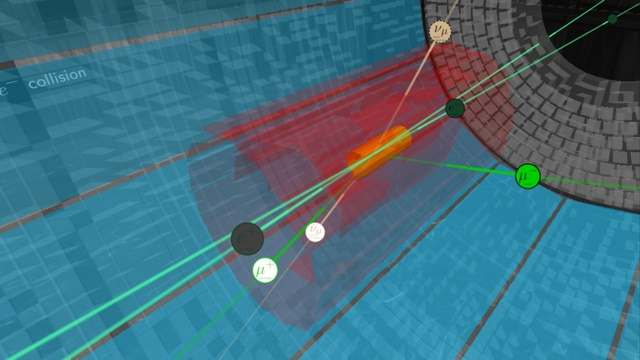Apr 9 2020
For approximately one year, the Belle II experiment has been gathering information from physical measurements. Following many years of rebuilding work, the Belle II detector and the Super KEKB electron-positron accelerator have been optimized than their predecessors to realize a data rate that is 40 times higher.
 The Belle II detector searches for the Z' boson. This particle could reveal itself by an unexpectedly high number of muon pairs with opposite charges, as shown here. Image Credit: Belle II.
The Belle II detector searches for the Z' boson. This particle could reveal itself by an unexpectedly high number of muon pairs with opposite charges, as shown here. Image Credit: Belle II.
Researchers at 12 German research institutions are engaged in developing evaluation algorithms, building and operating the detector, and examining the data. Johannes Gutenberg University Mainz (JGU) has extended its support to this project by designing and programming unique electronics for tracking the pixel vertex detector.
Using the Belle II detector, researchers are searching for traces of new physics that can be leveraged to describe the irregular occurrence of both matter and anti-matter and the enigmatic dark matter.
Z′ boson is one of the unidentified particles that the Belle II detector has been searching for to date. This particle is a variant of the Z boson, which serves as an exchange particle for the feeble interaction.
Until now, it has been known that approximately 25% of the universe contains dark matter, while visible matter makes up just below 5% of the energy budget. The two forms of matter attract one another via gravity. The resultant dark matter serves as a kind of template for scattering the visible matter. This can be observed, for instance, in the alignment of galaxies in the universe.
Link Between Dark and Normal Matter
The Z′ boson particle may have a fascinating role to play in the interaction between visible matter and dark matter. In fact, it might be a kind of mediator between both forms of matter.
At least, from a theoretical standpoint, the Z′ boson can occur from the collision of positrons (anti-matter) and electrons (matter) in the SuperKEKB and subsequent decay into invisible dark matter particles.
Therefore, the Z′ boson could help researchers to interpret the behavior of dark matter. In addition, the discovery of the Z′ boson could elucidate other observations that are inconsistent with the fundamental theory of particle physics—that is, the Standard Model.
The Detection of Muon Pairs as an Important Clue
However, how can the Z′ boson be detected by the Belle II detector? Obviously, not directly. Simulations and theoretical models have predicted that the Z′ boson could expose itself via interactions with muons, which are the bulkier relatives of electrons.
If researchers can find an exceptionally high number of muon pairs of opposite charge after the collisions of positrons and electrons and abrupt differences in momentum and energy conservation, this would be a significant sign of the Z′ boson.
But the latest Belle II data is yet to give any indication of the Z′ boson. Now, armed with the latest information, the researchers can restrict the mass as well as the coupling strengths of the Z′ boson with a precision that was not achieved in the past.
In 2018, these preliminary outcomes emerged from the analysis of a negligible amount of data that was gathered at the time of the start-up stage of the SuperKEKB. The Belle II detector went into full operation on March 25th, 2019.
From that time, the experiment has been gathering information while constantly enhancing the collision rate of positrons and electrons. As soon as the experiment is perfectly adjusted, it will offer significantly more information when compared to the recently reported analyses. Hence, the physicists are hoping to gain a better understanding of the nature of dark matter and other unresolved questions.
The German working teams in the Belle II experiment are financially supported by the following programs and institutions:
- German Federal Ministry of Education and Research (BMBF): collaborative research project “Exploration of the Universe and Matter” (ErUM)
- German Research Foundation (DFG) within the framework of Germany’s Excellence Strategy
- Quantum Universe: EXC-2121–390833306
- ORIGINS: EXC-2094–390783311
- Helmholtz Association
- European Research Council (ERC)
- Max Planck Society
- European Union’s Horizon 2020—grant agreement No. 822070